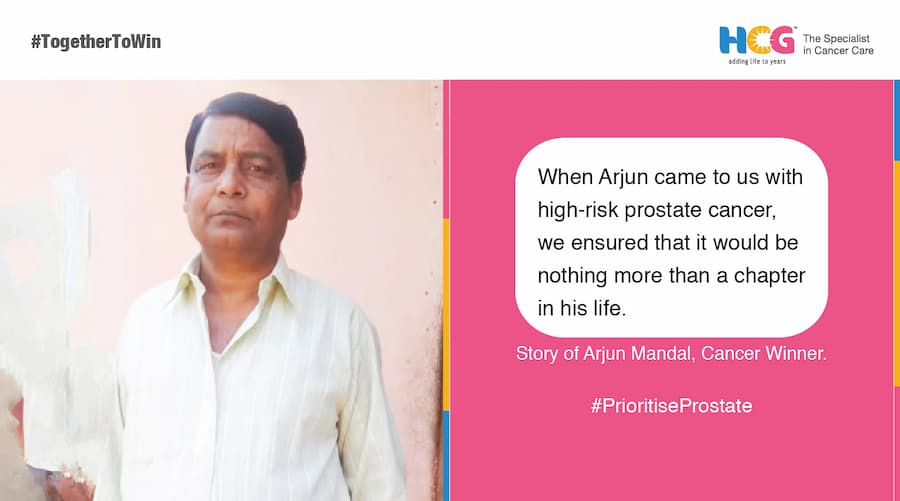
12 Nov, 2024

12 Nov, 2024

Medically Reviewed by Dr. Ramesh Uppada, MD, DrNB (Clinical Hematology)
Consultant – Hemato Oncology in HCG Cancer Centre, Visakhapatnam, on 4th Apr 2024
Globally, the month of September is observed as Blood Cancer Awareness Month. In India, blood cancer accounts for about eight percent of all cancer cases diagnosed.
Of all types of blood cancers, the three most common types that affect the Indian population are lymphoma, leukemia, and multiple myeloma.
Blood cancer means malignancies of the blood, bone marrow, or lymph nodes that result in uncontrolled blood cell production and altered function.
A cancer diagnosis can be overwhelming for both patients and their families. However, patients and their families must have an understanding of their condition and the treatment options available. This not only helps them make informed decisions but also helps them feel empowered.
"Misinformation and lack of awareness about blood cancer and its types are the biggest challenges observed today among the Indian population. Of the three forms of cancer, lymphoma can be cured if detected early.”
- Ramesh Uppada
Lymphoma is a type of blood cancer that affects lymphocytes, which serve as a major part of the immune system by fighting various infections and diseases. This cancer type develops in the lymphatic system, where disease-fighting antibodies are made.
Your lymphatic system is also responsible for cleaning your blood of toxins and waste products. Lymph nodes, spleen, thymus, tonsils, appendix, and a fluid called lymph together form your lymphatic system.
The abnormal lymphocytes usually build up in the lymph nodes of a person's armpits, neck, or groin; however, they can collect in almost any part of your body. Since lymphoma cells are mostly accumulated in the lymph nodes, their presence usually cannot be detected through blood tests.
Lymphoma can be seen in any age group. Certain types of lymphoma are more common in adults, while others are more common in children and adolescents.
If caught in the early stages, treating lymphoma cancer successfully through various treatment options is possible.
Before charting out a treatment plan, doctors will carefully review the case to understand the type of lymphoma, its stage, its grade, the patient’s age, and the patient’s overall health status.
Lymphoma is a type of blood cancer that affects the antibody-making cells of the immune system. It can be diagnosed in any age group. If detected early, lymphoma can be treated successfully using different personalized treatment approaches.
Hodgkin’s lymphoma and non-Hodgkin’s lymphoma are the two broad types of lymphoma cancer. These types are further classified into multiple subtypes based on the cell type that they arise from, growth rate, symptoms, prognosis, and other characteristic features. In the below table, you can see the characteristic features of these two main types of lymphoma.
| Characteristic Feature | Hodgkin’s Lymphoma (HL) | Non-Hodgkin’s Lymphoma (NHL) |
|---|---|---|
| Cell Type | Arises from both T-cells and B-cells | Primarily, it arises from the B-cells (a type of lymphocyte); however, it may also arise from T cells and NK cells |
| Presence of Reed-Sternberg Cells | Hodgkin’s lymphoma cancer is broadly classified into 4 subtypes | NHL has about 60 subtypes. |
| Prevalence | According to Globocan India 2022 Reports, Hodgkin’s lymphoma is relatively rare compared to non-Hodgkin’s lymphoma. | Globocan India 2022 reports suggest that NHL is relatively more common than HL. |
| Location | It usually forms in the upper part of the body. | Can form anywhere in the body. |
| Age Group Affected | HL is commonly seen in young adults between the ages of 15 and 40 and in adults aged above 55. | Non-Hodgkin’s lymphoma is common among adults aged above 60. |
| Symptoms | Reduced immunity, unexplained bruising and bleeding, palpable lymphadenopathy, unintended weight loss, fever, persistent fatigue, breathlessness, etc. | Same as HL |
| Treatment | Treatment options include chemotherapy, radiotherapy, targeted therapy, immunotherapy, and bone marrow transplant. | Same as HL |
| Prognosis | The prognosis for HL is good if it is detected and treated in the early stages. Also, the prognosis of HL is better than that of NHL. | The prognosis of NHL depends on various individual case factors. The aggressive NHL types may have a relatively less favorable prognosis than the HL, whereas indolent NHL types have a relatively more favorable prognosis. |
Hodgkin’s lymphoma and non-Hodgkin’s lymphoma are the two main types of lymphoma. Both types have their own characteristic features, and their symptoms and treatment approaches are also somewhat similar.
The prognosis, however, is better for Hodgkin’s lymphoma than non-Hodgkin’s lymphoma, provided the former is diagnosed in the early stages.
In some cases, patients may experience early signs of lymphoma, whereas in other cases, there may be no symptoms at all. The most common symptom of lymphoma is a painless swelling in the lymph node. Some of the other common lymphoma cancer symptoms include:
In our body, healthy lymphocytes travel around the body as part of the immune system, thereby when a healthy person has an infection, lymph nodes trap bacteria and viruses that they cannot destroy immediately, and as a result, they swell and become tender to touch. A diagnosis of lymphoma is made after performing blood tests and imaging tests and by obtaining a biopsy of the enlarged node and performing immunohistochemistry on the same tissue.
"The signs and symptoms of lymphoma are quite generalized and similar to less serious illnesses such as influenza or other viral infections, which means that they can easily be overlooked. However, the symptoms of an acute infection in a normal individual are short-lived and resolved over time, whereas in the case of lymphoma, they persist."
Dr. Ramesh Uppada
Here is one of our cancer warriors sharing their experience dealing with stage 4 Hodgkin’s lymphoma:
"The best course of action in the management of lymphoma depends on the stage of the cancer. "While the mainstay of treatment in blood cancers is chemotherapy with or without radiotherapy, some patients can also be treated with targeted therapy, immunotherapy, or hematopoietic stem cell transplant.”
Dr. Ramesh Uppada
While many know that blood cancer is a serious health condition, not many know it is treatable. The survival rates are also excellent if this disease is caught in its early stages. More awareness needs to be created among the masses on the different types of blood cancer, their symptoms, and what one should do when one starts experiencing blood cancer symptoms. Raising blood cancer awareness can play a critical role in patients and their families making informed decisions and putting themselves a step ahead of this disease.
There has been a lot of research in the lymphoma cancer space, leading to several new treatments, which is good news. With the advent of new, effective treatments and the evolution of medical science, there is hope for lymphoma patients, as research is churning out new and effective therapies.
Non-aggressive forms of lymphoma progress slowly and do not cause any symptoms in the early stages. In such cases, patients may have lymphoma and not know it, sometimes for years. In the case of aggressive lymphoma, the disease progresses rapidly and presents with various symptoms.
In order to detect lymphoma in the early stages, one must be aware of the different symptoms of lymphoma and undergo regular health check-ups, especially if they are high-risk individuals.
Various factors, such as the type of lymphoma, its stage, age, and overall health of the patient, as well as the treatment response shown by the patient, determine the survival rate. In India, the 5-year survival rate for Hodgkin’s lymphoma stands at 83–84%. The 5-year survival rate for non-Hodgkin’s lymphoma, on the other hand, stands at 83% when the disease is confined to a signal region. Even the most advanced stage of non-Hodgkin’s lymphoma has a survival rate greater than 60%.
Lymphoma is a serious condition, and it demands prompt medical attention. If left untreated, it can disrupt the body’s immune system and spread to different parts of the body.
This condition primarily arises from the lymph nodes, which are present throughout the body. Some of the early signs and symptoms of lymphoma include swelling of the lymph nodes, tiredness that does not go away, fever, loss of appetite, weight loss, and night sweats.
Usually, lymphoma can be categorized into 4 stages – stages 1, 2, 3, and 4. Stages 1 and 2 refer to the early stages of lymphoma, whereas stages 3 and 4 refer to the advanced stages.
In the early stages, the disease is localized and relatively easier to treat. However, in the advanced stages, the disease has spread to nearby and distant organs and will need aggressive treatment regimens.
Commonly observed early signs of lymphoma include swollen lymph nodes, persistent tiredness, fever, unexplained bruising and bleeding, and recurrent infections.
There are multiple tests available for the diagnosis of lymphoma, and they include physical examination, blood tests, imaging tests, and biopsy.
Lymphomas primarily start in the lymph nodes that are present throughout the body, and as the disease progresses, organs such as the spleen, bone marrow, liver, lungs, and bone may be affected.
A Guide to Hodgkin’s Lymphoma and Non-Hodgkin’s Lymphoma Similarities and Differences: https://www.britishjournalofnursing.com/content/lymphomas/a-guide-to-hodgkin-and-non-hodgkin-lymphomas-similarities-and-differences/
Global Cancer Observatory 2022 – India Fact Sheet: https://gco.iarc.who.int/media/globocan/factsheets/populations/356-india-fact-sheet.pdf
Real-World Outcomes of Hodgkin Lymphoma: A Multi-Centric Registry From India: https://www.ncbi.nlm.nih.gov/pmc/articles/PMC8881143/
Author Bio : Dr. Ramesh Uppada
MBBS, MD, DrNB (Clinical Hematology)
Consultant Hematologist
Dr. Ramesh Uppada is one of the best hematologists in Vizag with over 8 years of experience in managing benign and malignant blood diseases in both adult and pediatric patients. He has vast experience in doing bone marrow transplants for different types of blood diseases. His treatment approach is focussed on providing patient-specific and evidence-based solutions for their hematological and oncological needs.
During his free time, Dr. Ramesh likes to read journals and listen to music.
To book an appointment with Dr. Ramesh Uppada, please click here.
